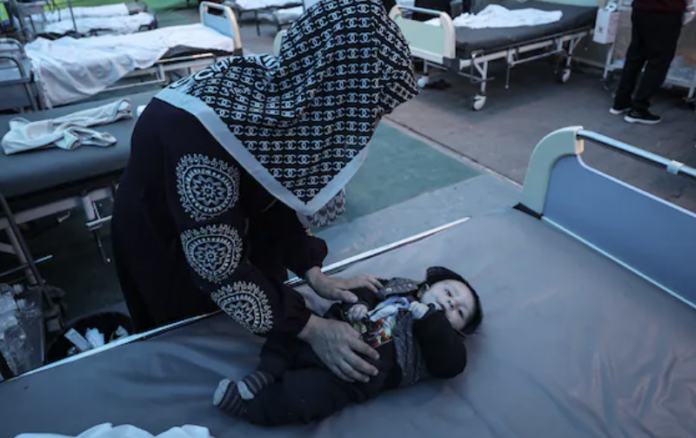The World Health Organization warns that the health care system in GAZ is "destroyed" and "alarm signals about epidemic diseases" appear.
Abu's 2-year-old daughter suffers from diarrhea, vomiting, sneezing and "trembling with cold and lack of food,"-said to have six children in an interview with The Washington Post from the southern city of Han-Yunis in the south of Gaza. The baby “asks me all the time, but I am unable to give it,” Abu Taim said. "So I have to give her anything, even if it is contaminated."
The 42-year-old Abu Taim has a thyroid cancer. But it also developed a severe respiratory infection, caused, as it believes, by pollution caused by war: dust and other particles that remain after Israeli bombing for a long time. Without electricity or fuel, it burns firewood to warm up the family, "although I am sure that the smoke that is formed will kill me."
She was able to receive medical care. The family found shelter at Nasser's hospital, but the crowded institution only provides restricted assistance to the hardest wounded. Patients and displaced persons accumulated together without clean water and sanitary conditions are rapidly spreading infections. Abu-Tima has no access to medication.
"We are not alive," she says. "We are dead, but we have living skeletons."
After 10 weeks of Israel's military campaign against Hamas, overflowing, besieged, fired, hungry Gaza became a favorable ground for disease spread.
According to the Ministry of Health Gaza and individual doctors, the number of cases of staphylococcal infection, chickenpox, rash, urinary tract, meningitis, epidemic mumps, scabies, measles and food poisoning are increasing. WHO is especially concerned about bloody diarrhea, jaundice and respiratory infections. The United Nations monitors 14 diseases with "epidemic potential".
"It is expected that the risk will worsen with the deterioration of the situation and the approach of winter conditions," the WHO said.
The conflict broke out when Hamas and their allies left Gaza on October 7 and attacked the Israeli communities. They killed 1,200 people and took 240 back to the enclave as hostages.
Israel responded to a military campaign aimed at eliminating Hamas. According to the Ministry of Health Gaza, the Israeli forces killed about 18,800 people in the enclave and wounded more than 50,000.
This month, WHO CEO Tedros Adhan Hebraesus said that "the needs for health care have increased sharply, and the health care capabilities have decreased to one third of what was."
Two -thirds of primary care centers are closed, WHO reports; 11 of the 36 hospitals are partially functioning. The UN Agency for Palestinian Refugees is managing nine of 28 of its primary care clinics. Almost 85% of Gaza residents were forced to leave their homes, and about 1.3 million people live in shelters, with an average of one toilet for 220 people and one shower for 4.5 thousand.
Of particular concern are the outbreaks of the epidemic in Rafach, where almost half of the 2.1 million residents of the enclave are hidden in houses, schools, camps and on the streets. Israel urged Palestinians to move to the southern city for their safety.
Children were most affected. Cases of diarrhea in children were jumped by 66% from November 29 to December 10, and among adults this figure is 55%, according to WHO.
From October 7, Naim Al-Tatri and her children moved four times. Now the family lives in a tent near a school in Rafach.
"My children have digestive problems, they are constantly blowing, and I can't find a way to cure them," says 37-year-old al-Tatri. "Hospitals are crowded. There are no services at all. No international organization attended us.
"I wonder," she said, "Where is the world looking at our suffering?"
16-year-old Affshur Half fights with chickenpox, respiratory disease, digestive and urinary tract infection problems, in addition to already existing liver problems, she told The Post.
Five years ago, Hali underwent surgery to no longer need dialysis. But with the beginning of the war, she said, she cannot find the medicine she needs. She and her six sisters moved from Gaza twice before they came to Rafach last month. They stopped at a school crowded with other persons displaced. Their father remained to look after his blind summer mother.
In Rafah, according to Halli, she and her sisters have problems with breathing. Then "some strange bubbles began to appear on my body," she said. The doctor told her that it was a windmill, and gave a lotion.
It should apply a lotion twice a day, but "I have no place where I could be alone." According to her, she feels constant pain and cannot sleep. Her clothing rubs papules from chickenpox. She has a headache, bones and fever. According to her, the urinary tract infection developed because she could not "regularly use the toilet because of a large number of displaced persons" and long queues at school.
Even before the war, the need for health care in gas was acute. Many residents of Gaza have already suffered from difficult health problems. Hospitals suffered from frequent disruptions with electricity supply and lack of medicines. Palestinians with serious illnesses had to receive hard -to -reach Israeli permits to leave the enclave for treatment.
The fourteen -year -old Abdul Hamid Kadukha had a meeting and permission to leave for Israel to treat head injury on October 8, his father reported. He never left.
After the attack by Hamas, on October 7, Israel was sealed by Anclaw and struck the Air Force. According to Saif Al-Dina Kadukha, a week after the war, his family of 11 people fled from his home in Karam to the Nusayrat Refugee camp in the central part of Gaza.
Shortly after arrival, according to Kadukha, his son was tired. He didn't want to eat. He faded, his eyes turned yellow. The doctor told them that it was viral hepatitis.
After the strike that took place nearby, the family escaped to Rafach, where they live in a tent near school. Kadukha says there is no way to stay clean. They receive water only every three to four days from the United Nations.
Kadukha panic because his son's condition deteriorates. "I have lost my children not from rockets, but now I see how they die of illness," he says.
Mohammed Madi, a doctor, spent the first five weeks of war at Rantisi Children's Oncology Hospital in Gaza. In November, Israel ordered hospitals to be evacuated. Madi removed several patients and went to Rafach.
He and his family live at a school with about 2,000 people who do not have medical care. There are usually small clinics on the UN objects. But in public schools, where thousands of Palestinians settled, they are not.
Madi with several medical colleagues organized a small clinic at school.
"We began to specifically deal with cases of infection, scabies, intestinal infections and chest infections," he says. "Several patients with hepatitis A have received."
The displaced doctors and gase nurses opened similar clinics in other places. Israel sharply reduced the flow of health care, but approved the importation of materials for field hospitals in the south, funded by countries such as the United Arab Emirates.
"There are permanent hospitals throughout the Gaza, which can and should be used safely, without the risk of shelling, siege or deprivation of critically important deliveries, including fuel, water and basic medicines," said Tanya Hadzh Hassan, a doctor of the organization "doctors without borders" who worked in gas.
According to her, initiatives financed from abroad are only a temporary solution to combat disease.


